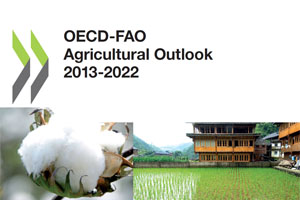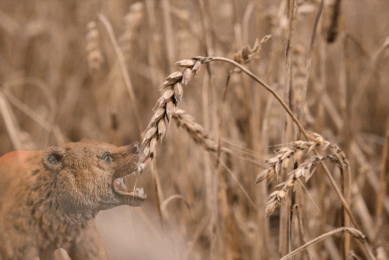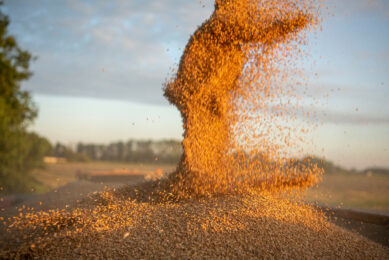OECD-FAO Agricultural Outlook 2013-2022 published

The Agricultural Outlook, 2013-2022, a collaborative effort of the Organisation for Economic Co-operation and Development (OECD) and the Food and Agriculture Organization (FAO) of the United Nations has now ben published.
The report brings together the commodity, policy and country expertise of both organisations and input from collaborating member countries to provide an annual assessment of prospects for the coming decade of national, regional and global agricultural commodity markets.
For decades, global agriculture was characterised by policy-induced production surpluses in industrialised countries and stagnating growth in developing countries. Policy reforms and economic growth across the globe have been changing demand and supply fundamentals sufficiently to turn agriculture into a more market-driven sector which provides investment opportunities, particularly in developing countries. Agricultural trade is projected to increase with developing countries capturing most of the export growth.
Expansion of agricultural production is likely to slow at least in the medium term with slower area and productivity growth. Supply should keep pace with demand at prices that are expected to remain relatively high. In this context, measures to reduce food loss and waste will be important in meeting rising demand and for increasing productivity.
With one-fifth of the world’s population, high income growth and a rapidly expanding agri-food sector, China is a special focus of this Outlook. Developments in Chinese agriculture may have a major influence on world markets. With increasing production constraints and strong demand growth, additional agricultural imports may be anticipated. Still, China should remain self-sufficient in the main food crops despite its relatively limited per capita agricultural resource endowments. Food security has improved as high income and agricultural growth has reduced the number of undernourished people from 21% in 1990 to 12% today but more still needs to be done as the economy expands.
Key messages
• Macroeconomic uncertainty. Although relatively resilient to economic downturns, agricultural markets continue to reflect the impact of a two speed global economy with weak recovery in developed countries and vibrant growth in many developing countries. Rising oil prices are an important and uncertain assumption underlying the agricultural price projections. A depreciating US dollar is expected to reduce the relative competitiveness of other exporters while increasing the purchasing power of many importers.
• Near term prices adjusting. Commodity prices are currently high by historical levels. In the first years of this Outlook, crop and livestock prices are expected to diverge, reflecting different supply situations. Most crop prices are projected to fall in response to a rebound in production while reduced global livestock inventories allow only a limited supply response keeping meat prices high.
• Prices firming over the medium-term. Rising prices for both crop and livestock products are projected over the coming decade due to a combination of slower production growth and stronger demand, including for biofuels, and a supportive macroeconomic environment. Meat, fish and biofuel prices are projected to rise more strongly than primary agricultural products.
• Inflation adjusted prices remain high. Over the next decade, average prices for the crop complex (cereals, oilseeds, sugar and cotton) are expected to be relatively flat in real terms compared with the previous decade which included several years of record high prices since 2007. Average real prices for the 2013-22 period are projected well above the 2003-12 average for most of the other commodities covered in this Outlook.
• Lower food price inflation. Recent evidence indicates that consumer food price inflation is currently abating in most countries, as lower prices of food grains, oilseeds, sugar and other products are passed through the food chain contributing to lower the ―core‖ inflation. Nevertheless, with food expenditures accounting for 20-50% or more of household budgets in many developing countries, food affordability remains a main concern for food security.
• Slower production growth. Global agricultural production for commodities covered in this Outlook is projected to grow at 1.5% annually, on average, compared to 2.1% in the previous decade. This slower growth is expected to be exhibited by all crop sectors and livestock production. These trends reflect rising costs, growing resource constraints, and increasing environmental pressures, which are anticipated to inhibit supply response in virtually all regions.
• Developing countries increase output. Higher production growth is expected from emerging economies which have invested in their agricultural sectors and where existing technologies offer good potential for closing the yield gap with the advanced economies, although yield/supply variability may be higher. The share of production from developing countries continues to increase over the outlook period.
• Strong demand growth. Consumption of all products covered in this Outlook will increase in developing countries, albeit at a slower pace, driven by growing populations, higher incomes, urbanisation and changing diets. Per capita consumption is projected to expand most rapidly in Eastern Europe, and Central Asia followed by Latin America and other Asia.
• Agriculture trade continues to increase. Emerging economies will capture much of the trade growth, accounting for the majority of exports of coarse grains, rice, oilseeds, vegetable oil, sugar, beef, poultry and fish. The OECD area share of trade will continue to decline while remaining the major exporters of wheat, cotton, pig and sheep meat and most dairy products.
• Outlook uncertainties. Production shortfalls, price volatility and trade interruptions remain a threat to global food security. As long as food stocks in major producing and consuming countries remain low, the risk of price volatility is amplified. A wide spread drought like that experienced in 2012 in the United States and CIS countries, on top of low stocks, could raise crop prices by 15%-40%. A statistical analysis projecting past uncertainty patterns on relevant model drivers into the baseline period, shows crop yield variability to have the largest impact on world prices for wheat, coarse grains and oilseeds with rice somewhat less sensitive. Meat, dairy and biofuel prices are more affected by macroeconomic assumptions such as economic growth and exchange rates. Energy prices add another source of uncertainty, affecting both biofuel markets and input costs. World trade is even more sensitive than production to yield variability and macroeconomic drivers.











